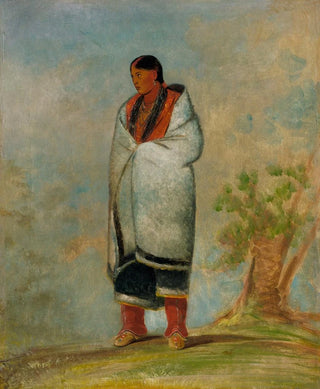Art print | WaQuthEQua The wife of the Bucks The wife of the whale - George Catlin


View from behind

Frame (optional)
In the fascinating world of 19th-century American art, the artwork "WaQuthEQua L'épouse des Bucks L'épouse de la baleine" by George Catlin stands out for its narrative depth and visual richness. This iconic piece, which captures the essence of Native American cultures, transports us to a world where every detail tells a story. Catlin, as a keen observer, immortalized scenes from the daily life of Native tribes, offering a valuable testimony of a bygone era. Through this art print, viewers are invited to explore not only the aesthetic beauty of the work but also its historical and cultural context.
Style and uniqueness of the artwork
George Catlin's style is characterized by a realistic approach and meticulous attention to detail. In "WaQuthEQua L'épouse des Bucks L'épouse de la baleine," the artist depicts a Native American woman in all her splendor, dressed in traditional adornments that evoke the richness of her culture. The vibrant colors and carefully rendered textures testify to Catlin's technical mastery. Every element, from the intense gaze of the woman to the delicacy of her ornaments, invites discovery of the customs and beliefs of the peoples he encountered. This work is not limited to a simple representation; it is a celebration of identity and cultural heritage, capturing the harmony between the individual and their environment.
The artist and his influence
George Catlin, often considered the first painter to dedicate his career to depicting Native Americans, played a crucial role in preserving their image at a time when their way of life was threatened by colonial expansion. Born in 1796, Catlin traveled across the United States, meeting various tribes and documenting their traditions through portraits and scenes of daily life. His work not only helped raise public awareness of the richness of Native American cultures but also influenced many artists and writers. Through his artworks, he created a bridge between cultures, emphasizing the

Matte finish

View from behind

Frame (optional)
In the fascinating world of 19th-century American art, the artwork "WaQuthEQua L'épouse des Bucks L'épouse de la baleine" by George Catlin stands out for its narrative depth and visual richness. This iconic piece, which captures the essence of Native American cultures, transports us to a world where every detail tells a story. Catlin, as a keen observer, immortalized scenes from the daily life of Native tribes, offering a valuable testimony of a bygone era. Through this art print, viewers are invited to explore not only the aesthetic beauty of the work but also its historical and cultural context.
Style and uniqueness of the artwork
George Catlin's style is characterized by a realistic approach and meticulous attention to detail. In "WaQuthEQua L'épouse des Bucks L'épouse de la baleine," the artist depicts a Native American woman in all her splendor, dressed in traditional adornments that evoke the richness of her culture. The vibrant colors and carefully rendered textures testify to Catlin's technical mastery. Every element, from the intense gaze of the woman to the delicacy of her ornaments, invites discovery of the customs and beliefs of the peoples he encountered. This work is not limited to a simple representation; it is a celebration of identity and cultural heritage, capturing the harmony between the individual and their environment.
The artist and his influence
George Catlin, often considered the first painter to dedicate his career to depicting Native Americans, played a crucial role in preserving their image at a time when their way of life was threatened by colonial expansion. Born in 1796, Catlin traveled across the United States, meeting various tribes and documenting their traditions through portraits and scenes of daily life. His work not only helped raise public awareness of the richness of Native American cultures but also influenced many artists and writers. Through his artworks, he created a bridge between cultures, emphasizing the






